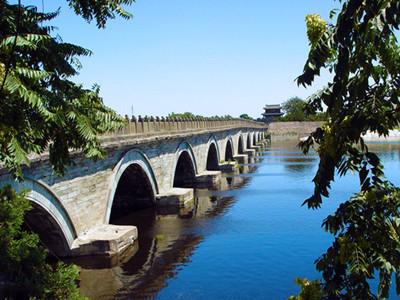Marco Polo Bridge [ Related Itinerary ]
 Marco Polo Bridge, also known as Lugou Bridge is located in the city of of Wanping, 15 kilometers from Beijing city proper. First constructed in the year of 1192, the bridge is a large granite structure of 11 arches that spans the Yongding River, which was listed into the "Eight Scenic Spots of Yanjing (Beijing)" under the title "Lugou Xiaoyue".
Marco Polo Bridge, also known as Lugou Bridge is located in the city of of Wanping, 15 kilometers from Beijing city proper. First constructed in the year of 1192, the bridge is a large granite structure of 11 arches that spans the Yongding River, which was listed into the "Eight Scenic Spots of Yanjing (Beijing)" under the title "Lugou Xiaoyue".This bridge is famous abroad because it is mentioned by Marco Polo, a European explorer who visited China in Yuan Dynasty during the 13th century. Also the bridge is famous in China because it witnessed an important historical event: on July 7, 1937, when Japanese troops fired the first shots, it led China into World War II and this incident is commonly regarded as the start of a major war between then Imperial Japan and the Republic of China. The Lugou Bridge is situated at a strategic point on the one overland route to the capital from the south. Japanese and Chinese soldiers started shooting, giving Japan an excuse to attack and occupy Beijing.
Standing over the Yongding River for 800 years, the entire bridge is made of huge granite blocks. With the totally length of 260 meters, though not exactly an engineering marvel, the highlight is that there has 250 marble balustrades supporting 485 carved stone lions crouched along the railings on both sides. Local people claimed that the lions are too many to be counted. Being the highlight of Marco Polo Bridge is not only because the number of the stone lions, the most important reason is that take a close look at the stone lions, no two lions are alike and smaller carved lions can be found strategically placed on and beside them.
At both ends of the bridge stand imperial steles - large stone slabs with historic calligraphic writing. one describing the renovation by the Kangxi Emperor in 1698, and the other with the characters in the Qianlong Emperor's handwriting.
To enjoy a suburb view of Beijing and explore the history of China, visit Marco Polo Bridge is a nice choice.
Related Itinerary